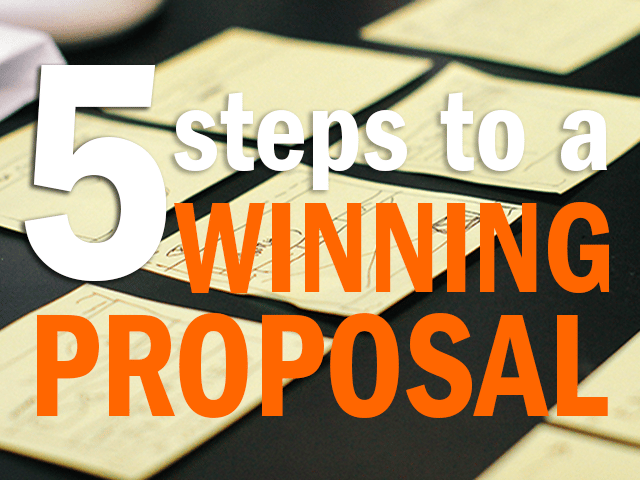A well-crafted proposal is a beautiful thing. A compelling presentation combined with persuasive value language and stellar strategic thinking will always win the day over plodding, hackneyed lists of services and costs.
Even better is the proposal that is accepted before it is written.
Here are five ground laying steps that can improve the win percentage of your proposals.
1. Submit the proposal only when it is ready to be accepted.
A proposal is not a pitch document; it is the closing stage of your sales process.
I never use it as part of a fishing expedition. There are better options to divine a prospects’ needs – not the least of which is asking them about their needs.
Any good sales trainer will tell you that if someone requests a proposal casually or at a suspiciously early stage of the contact process, they aren’t serious. They also may have other reasons for asking for it beyond doing business with you. At best it’s a waste of time. At worse, it will give your competitors information that they can use to beat your proposal.
This is a perfect example of a situation in which the famous Sandler Sales System “upfront contract” strategy should be used (get an agreement that if the proposal is submitted with the parameters you are discussing, it will be accepted).
Action Step: Meet with the prospect to do more qualifying. Once you have a sense of their need, you can test the waters with an informal idea session to get an agreement that your approach will work.
2. Ensure you have the leadership’s support.
In a perfect world, I would only submit a proposal to a CEO. That’s not real life. To have any chance of success, however, the program you propose must resonate with the leadership’s agenda and current initiatives. If you can get a meeting with the boss to ensure that, by all means, do it. You can use it to get buy-in (or to identify the changes needed to achieve buy-in).
If you can’t get that meeting, you should pursue as far up the management chain as you can go. The right senior champion can be as valuable as the CEO. Conversely, if you can’t get a decision maker on board, then give serious consideration whether it is worth the effort to pursue the proposal stage.
Action Step: Start pursuing up the food chain by conducting informational interviews to either get the boss on board or identify additional champions.
3. Identify all the stakeholders and attempt to meet their needs.
Champions are great. Not having someone behind your back with a knife is also nice.
I have had proposals killed because they were ambushed by “not invented here” syndrome. In a disappointing instance, one died because another department felt it stepped on their toes.
My bad. I forgot that the agenda you don’t know will hurt you. You may not be able to recruit everyone in support of your program, but you can remove threats to it by reaching out to them and creating a structure to involve other possible stakeholders.
Action Step: Make certain you understand who else may have a stake in this program and get them on board to the greatest extent possible.
4. Know what has been tried before and why it worked, or why it failed.
If you have done your due diligence discussed in steps 2 and 3, somewhere along the way you likely have discovered what your prospect has tried previously.
Or not. You can’t assume previous efforts don’t exist just because no one told you about them.
Ask directly.
It doesn’t matter whether they were bad or good. If they were duds, you can use them to answer the objection you know is coming before it is asked: What makes your plan different? If they were successful, you can use them to explain how your program will stand on the shoulders of giants. (That previous effort was somebody’s baby – make nice.)
Action Step: Make sure you know the history of the solutions tried and position your proposal as a positive addition.
5. Identify what kind of consultant/vendor/partner your prospect prefers.
Not all failed proposals do so on the strength of solutions and costs. People do business with those they like and trust. It will tell you a great deal about how to close the sale by understanding the types of partners they have chosen previously.
At the very least, you can turn negatives into positives in your proposal. (E.G., If you are smaller than normal, you can use the big fish/small pond tactic.)
Action Step: Ask the people you interview at the prospect firm to tell you who their favorite and most successful vendor is and why.
In the real world, we rarely get the perfect conditions for a proposal, but we do not have to be at the mercy of the winds of chance. Follow these simple steps and you can dramatically increase your win percentage.

